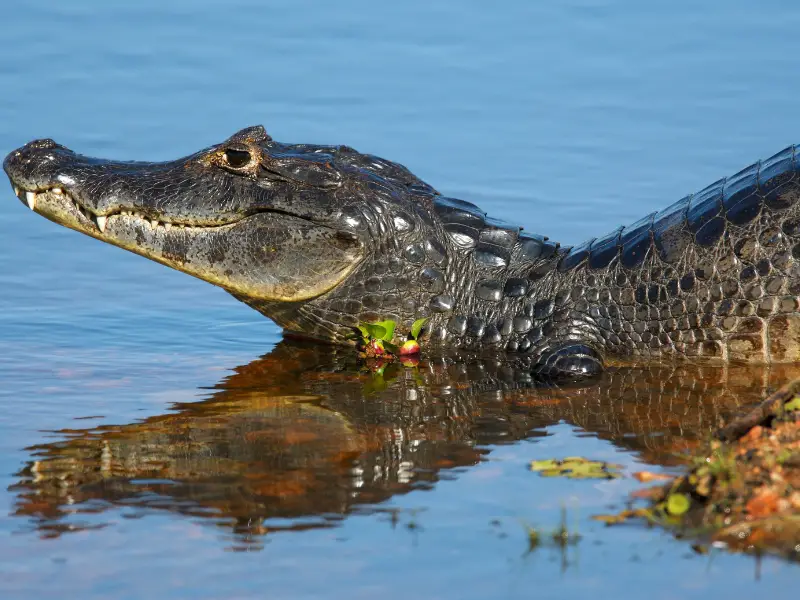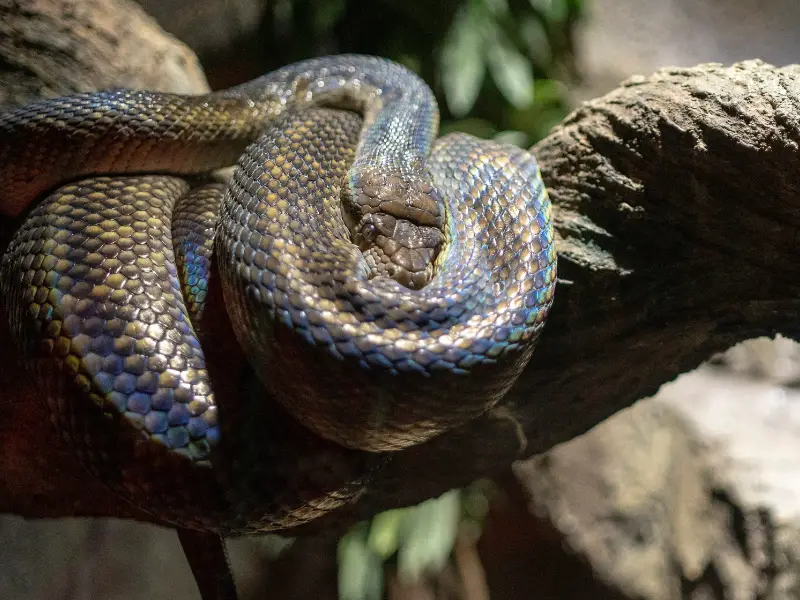The caiman crocodile is a fascinating reptile, but it’s not suitable for the average enthusiast.
There are six species of caiman crocodile in total. And although they each possess a unique appearance and set of traits, none are easy to handle.
These carnivorous, semi-aquatic reptiles are built to live in the rivers, swamps, marshes, and forests of South and Central America. They don’t enjoy being handled, and they can’t be tamed, which is why an experienced handler is an ideal owner.
If this tough reptile has caught your eye, and you’re interested in learning more about them and how to care for them, continue reading to see if you have what it takes to raise one.
Quick Facts
| Common name | Caiman crocodile, cayman |
| Scientific name | Caiman (genus) |
| Adult size | 6.6-8.2ft long (4.9 for a dwarf caiman), 13-88 pounds |
| Lifespan | 30-50 years for the smaller species, 50-70 for larger ones |
| Diet | Fish, insects, birds, small mammals, other reptiles |
| Tank size | 15x8ft for a dwarf caiman; bigger is always better |
| Humidity & temperature | 90-95°F basking area, 80-85°F rest of the enclosure, 72° water, 60-70% humidity |
| Popular alternatives | Blue-tongued skink, Uromastyx, black-throated monitor lizard |
What Is a Caiman Crocodile?
The caiman crocodile, sometimes spelled cayman, is a carnivorous reptile. Despite their name, they are closely related to the alligator.
They come in six different species, but all are long and squat reptiles. They have large jaws, short legs, and long tails. Their skin is thick and scaly, and their eyes and noses are located on top of their heads.
They predominately swim in the water, but they live part of their lives on land.
Types of Caiman Crocodiles
There are six species, all of which come with unique features.
Broad-Snouted Caiman
As its name suggests, the broad-snouted caiman has a wider nose in comparison to the other species. They are pale green, similar to the hue of an olive, and dwell in the still or slow-moving waters of the forest.
Their broad noses come in handy when they need to push foliage out of the way without disturbing predators or prey.
Black Caiman
Not only are black caimans the largest of the species, but they are also the most dangerous. In addition to being apex predators, they are not safe for human handling. They are very dark in color with pale bands around their jaws and can grow up to over 16 feet in length.
Unfortunately, these magnificent animals were almost hunted to extinction in the 1940s and 70s. But thanks to successful conservation efforts, they are no longer endangered.
Cuiver’s Dwarf Caiman
The smallest of the species is Cuiver’s dwarf caiman. They grow up to be between four to five feet in length. In addition to the short length, they also weigh just over 13 pounds.
Their relatively small size is the reason dwarf caimans are sometimes kept as pets. In the wild, they live near fast-flowing cool water they can easily hide under when they are hunting.
Smooth-Fronted Caiman
The smooth-fronted caiman is the second smallest species. They can grow to be four feet in length, with males sometimes growing up to be over six and a half feet. They are native to the Amazon and Orinoco basins.
Similarly to the Cuiver’s dwarf caiman, they are sometimes kept as pets.
Spectacled Caiman
These are the most commonly known of the species. What’s more, they are also the most frequently sighted of the entire crocodile family. They are referred to as spectacled because the bony ridge between their noses makes it look like they are wearing glasses.
They are much more adaptable when it comes to their surrounding habitat in comparison to the other species, but they live in salty water.
Yacare Caiman
The yacare caiman is similar to the spectacled caiman. Not only do they look the most like them, but they are also the most closely related of the species.
What makes them special is they eat piranhas, earning them the nickname “piranha caiman.” They are brown and considered medium-sized.
Caiman Crocodile Care Sheet
Enclosure
Caiman crocodiles require a large area that is half water within a secure facility. Enclosures come in various sizes, but they should be a minimum of 15 feet wide to eight feet long to adequately house a fully-grown dwarf caiman. These enclosures are typically made of glass.
You must also include a water filtration system for a 55-100 gallon aquarium for adults and 40 gallons for hatchlings. Additionally, the water should be deep enough to allow full immersion and be changed weekly.
Temperature and Humidity
Caimans require warm temperatures and a high level of humidity to survive. Therefore, the enclosure should include a UVA/UVB light source for day baking. Depending on the space’s size, you should use a 13- or 26-watt UVB bulb.
The heat source is important for digestion, behavior, and remaining social. They cannot absorb essential vitamins without the proper temperatures, leading to major health complications.
The basking area should be between 90-95 degrees Fahrenheit with a cooler area between 80-85 degrees Fahrenheit. You can keep the enclosure at the right temperature by using a 125-150 watt heat lamp. However, you should keep the water at room temperature, which is about 72 degrees Fahrenheit.
The overall humidity level should be between 60-70%.
Substrate
The enclosure’s land portion should be filled with a mix of bark, moss, mulch, and rocks.
We also recommend using gravel for the water substrate. It’s easier to clean and helps maintain the proper humidity level.
Hides and Decor
It’s essential to provide a place for your caiman to have privacy. Hides are especially important for hatchlings to keep them happy and healthy.
Caiman crocodiles are shy reptiles, so they require places to dig or hide.
Some items you can keep in their enclosure for decor include ceramic pots or modest furnishings. These items can help hide cords and other functional aspects of the enclosure that curious caiman may need to stay away from.
Keep in mind that you shouldn’t include any items in the enclosure that do not serve a necessary purpose for their happiness or health. Items that break can become hazardous to the caiman.
What Does a Caiman Crocodile Eat?
Caiman crocodiles are carnivorous, which means they eat meat. All of them eat fish and small mammals.
Since the different species vary in size, larger caimans can hunt large prey. This includes capybaras or even jaguars if they’re feeling lucky.
The black caiman is the largest of the six, and it’s also the apex predator in the Amazon.
How Long Do Caiman Crocodiles Live?
The life expectancies differ according to species, but they tend to live between 30-40 years. The larger caiman crocodiles can live as long as 90 years in the wild.
The dwarf caiman, the breed most commonly kept as a pet, lives to about 25 in the wild but can live as long as 35-40 years in captivity.
Caiman Crocodile Behavior
Caimans are known for their hostility, which is why they are not suitable for most reptile handlers to keep as pets. The Cuiver’s Dwarf, which is most commonly kept as a pet, is not comfortable being handled. Their bite can be painful, and their jaw is difficult to open once it closes.
Remember, they also do not bond well with humans and can’t be tamed. They tend to be aggressive in cases of defense and hunger but prefer to flee from other uncomfortable situations. They are wild animals, which means they can be unpredictable.
Caiman Crocodile Reproduction
Similar to most reptiles, caiman lay eggs. To prepare, female caiman crocodiles build a dirt nest with vegetation at the bottom. Over time, the vegetation rots and provides the necessary heat to keep the eggs warm before they hatch.
Caiman crocodiles can lay up to 40 eggs at one time. Interestingly, the sex of the hatchlings can be determined by minor temperature differences.
For example, a colder nest produces male hatchlings. That’s why some caimans lay their eggs throughout the layers of the nest to ensure a more proportionate gender distribution among their young.
All of the eggs hatch between 70-90 days. Soon after, the mother leads the hatchlings, known as a pod, to the water. Here, the mother will care for them in what is considered a nursery until they are old enough to fend for themselves.
How Much Does a Caiman Crocodile Cost?
Some species can be purchased as hatchlings for anywhere from $200 to $400. But you should consider the husbandry costs beforehand. Caiman crocodiles kept as pets have specialized water filtration, light, maintenance, and veterinary needs that can be expensive.
Due to their high needs, they can cost thousands of dollars. Additionally, you will need to pay for permits, high home insurance premiums, and administrative fees to complete the necessary paperwork.
Care Guide Summary
Caiman crocodiles are not suitable for the average reptile enthusiast. Before buying a caiman, you need to make sure you can provide the care, space, and money required to keep one safe. Otherwise, it’s recommended you consider caring for a more easy-going species.



